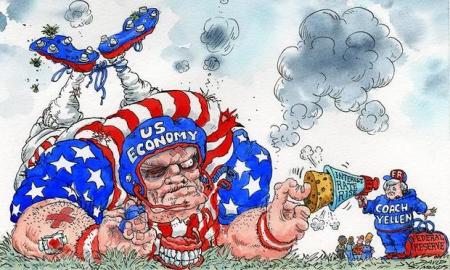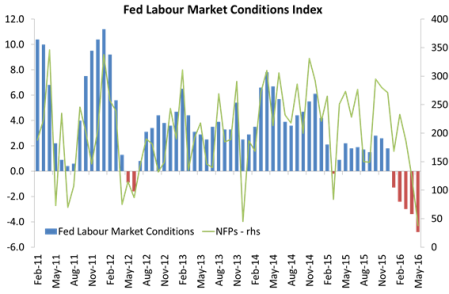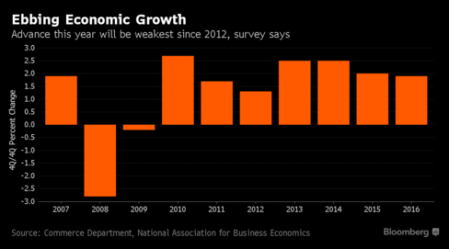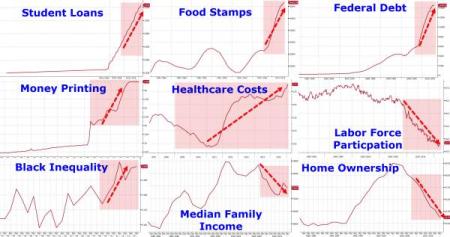Last December, the Federal Reserve decided to raise its policy interest rate for the first time since the Great Recession. At the time, the Fed thought that the US economy was starting to expand at a sufficiently fast rate that it would suck up all the unemployed and create conditions for increased demand and rising prices. Janet Yellen, the Federal Reserve chief explained that the US economy “is on a path of sustainable improvement.” and “we are confident in the US economy”. It was expected the Fed would proceed to raise interest rates by up to 1% point in 2016 in order to control inflation and avoid sharp wage rises.
Well, over six months later, the Fed has not raised interest rates again. And the reason is clear: US economic growth, far from being on a ‘path of sustainable improvement’, has been slowing. In the first quarter of 2016, real GDP growth rose only at an annual rate of 0.8%. And today, Yellen told the World Affairs Council in Philadelphia that the latest jobs growth figures had been disappointing, and while she remained optimistic, there was little ground for raising interest rates yet. Indeed, new jobs rose just 38,000 in May, half the consensus forecast of 160,000.

The US labour market, far from ‘tightening’, is beginning to weaken. The Fed’s labour conditions index was revised down to -3.4 from -0.8 in April while the May reading came in at -4.8, confirming an accelerating decline in conditions. This rate of decline has in the past presaged a new economic recession.

And according to a survey of mainstream economists by the National Association of Business Economics, US economic growth will slacken in 2016 to its slowest pace in four years, or just 1.9%, compared to a previous forecast of 2.5%. But even that could be optimistic.

Sure, the unemployment rate in May fell to 4.7%, the lowest since November 2007, but it did so for the wrong reasons as household employment barely rose. It’s just that the labour force shrank 458,000 as people are giving up looking for a job. The labour participation rate (the number of people working compared to those of working age), which had been picking up slightly, pulled back again.
There are currently 7.4 million American adults officially unemployed, but add in the ‘underemployment’ (part-time, temporary etc) and that number is much closer to 20 million. Full-time employment declined 59,000 on top of a 316,000 plunge in April. Those working part-time for economic reasons — actually preferring full-time employment but no such luck — jumped 468,000 in the sharpest increase for any month since September 2012.
Janet Yellen may think the US economy is getting better but the experience for Americans is different. Student loan debt has never been higher. Food stamp applications are at a record high. Healthcare costs continue to mount, and inequality increases while average family incomes fall.

The percentage of men aged 25 to 54 (prime working years) not working is at an all-time high. Real median household income is still 1.3% lower today than it was in 2007.
Growth in the productivity of labour is the benchmark for US economic growth. It declined at a 1.7% annual rate in Q4 of last year and followed that up with a 1.0% drop in Q1. Productivity is in decline because business investment growth has been weak. As I have argued before, business investment growth ultimately depends on the profitability of capital and profitability has remained low. And now total profits are falling. The NABE economists reckon corporate profits will fall this year for the first time since 2011, when they declined 2.9 percent.
I have argued in previous posts that the US economy will head into a new recession within the next year or two. According to JP Morgan, the US investment bank, the probability of a recession occurring within the next 12 months has never been higher during the current economic recovery. “Our preferred macroeconomic indicator of the probability that a recession begins within 12 months has moved up from 30% on May 5 to 34% last week to 36% today,”.
US recession

Nevertheless, Yellen continues to hope. “I see good reasons to expect that the positive forces supporting employment growth and higher inflation will continue to outweigh the negative ones,” Yellen said. “As a result, I expect the economic expansion to continue, with the labour market improving further and GDP growing moderately.” Watch this space.
No comments:
Post a Comment